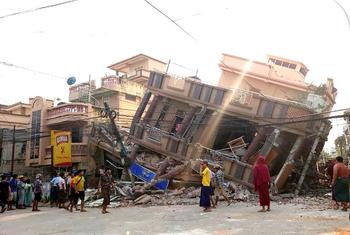More than 1,600 people have been killed and thousands injured after two powerful earthquakes rocked central Myanmar on Friday, flattening buildings and overwhelming hospitals in a nation already battered by conflict and disaster. The quakes, registering 7.7 and 6.4 on the Richter scale, struck northwest of Sagaing, leaving hundreds trapped under rubble and sparking a desperate international rescue effort.
The hardest-hit regions—Bago, Magway, Mandalay, Nay Pyi Taw, Northeastern Shan, and Sagaing—are grappling with collapsed homes, schools, and monasteries. In Mandalay, Myanmar’s second-largest city, more than 90 people are feared trapped in the wreckage of a single apartment building. Across the disaster zone, some 1,690 houses, 670 monasteries, 60 schools, and three bridges have been damaged, with officials warning that major dams could also be at risk.
“It’s chaos here,” said a local resident in Mandalay, where internet and phone lines are down, and roads and airstrips are barely usable. “We can hear people calling for help, but there’s only so much we can do.” Adding to the confusion, reports emerged of 50 construction workers missing in Bangkok, though it’s unclear how they connect to the Myanmar disaster.
A Nation in Crisis
Myanmar’s military government, which seized power in a 2021 coup, has called for global assistance as the death toll climbs. Yet opposition groups claim airstrikes by the military have continued in areas like Sagaing, even after the quakes, further endangering survivors. The country was already reeling from a civil war, last year’s devastating cyclone, and widespread flooding just seven months ago—crises that have left nearly 20 million people reliant on aid.
The United Nations (UN) estimates that Friday’s quakes have affected around 20 million people. “The resilience of these communities is hanging by a thread,” said Marcoluigi Corsi, the UN’s humanitarian coordinator in Myanmar, speaking from Yangon. “They need the world’s support—now more than ever.”
Rescue Efforts Ramp Up
The UN and its partners are rushing to deliver help, tapping into pre-stocked supplies in Mandalay and Naypyidaw to bypass early logistical hurdles. The World Health Organization is deploying emergency medical teams with trauma kits, blood bags, and mobile surgical units, while UNICEF is distributing tents, hygiene kits, and health supplies for children caught in the disaster.
“Kids are facing even greater hardship in an already dire situation,” said Trevor Clark, UNICEF’s regional emergency chief. “We’re ready to do more, but we need our partners to step up.”
Funding is trickling in: the UN’s Central Emergency Relief Fund has released $5 million, and the UN procurement agency, UNOPS, has added $10 million from donors. Still, with only 5% of this year’s humanitarian plan funded, aid groups warn they’re stretched thin.
A Race Against Time
Rescue teams are working around the clock to free survivors from the debris, but time is running out. Damaged hospitals are struggling to cope, with shortages of everything from anesthetics to beds. In some areas, field hospitals are being set up to handle the influx of injured.
The quakes have deepened Myanmar’s woes, exposing the fragility of a nation battered by years of turmoil. As the international community rallies, the UN has launched an emergency appeal for donations to bolster the response.
This story will be updated as more information becomes available.Source: UN News
A global media for the latest news, entertainment, music fashion, and more.





